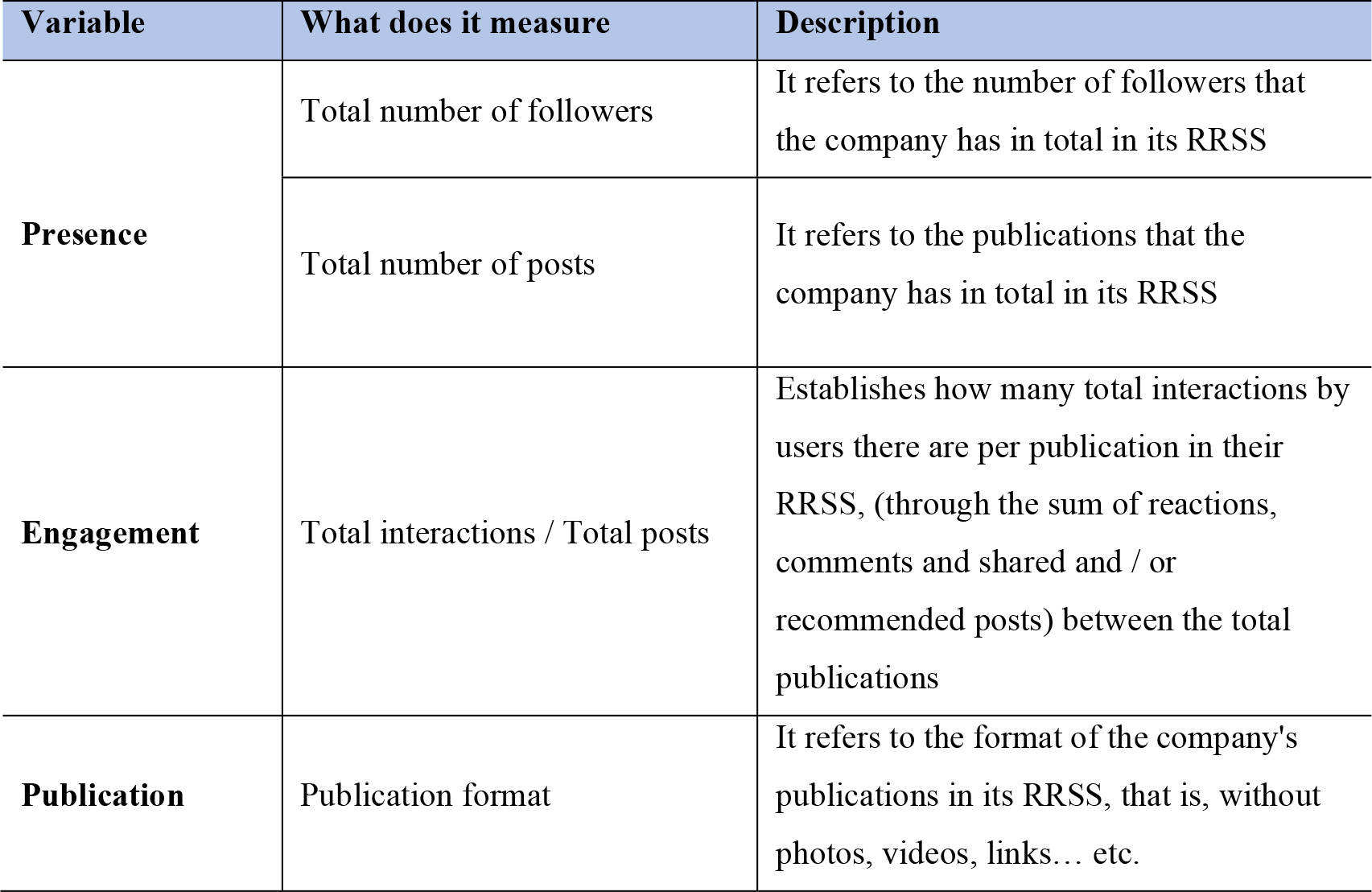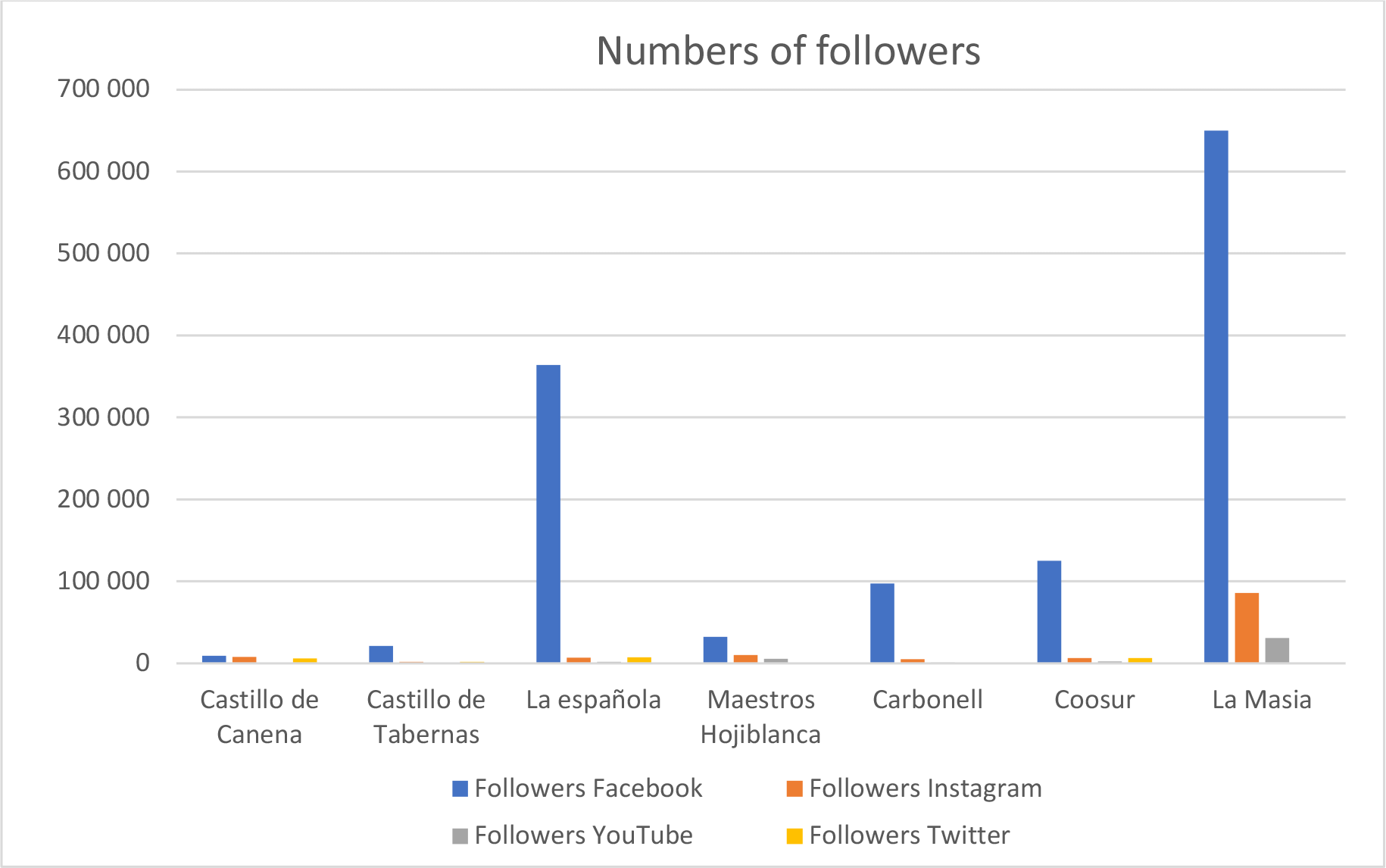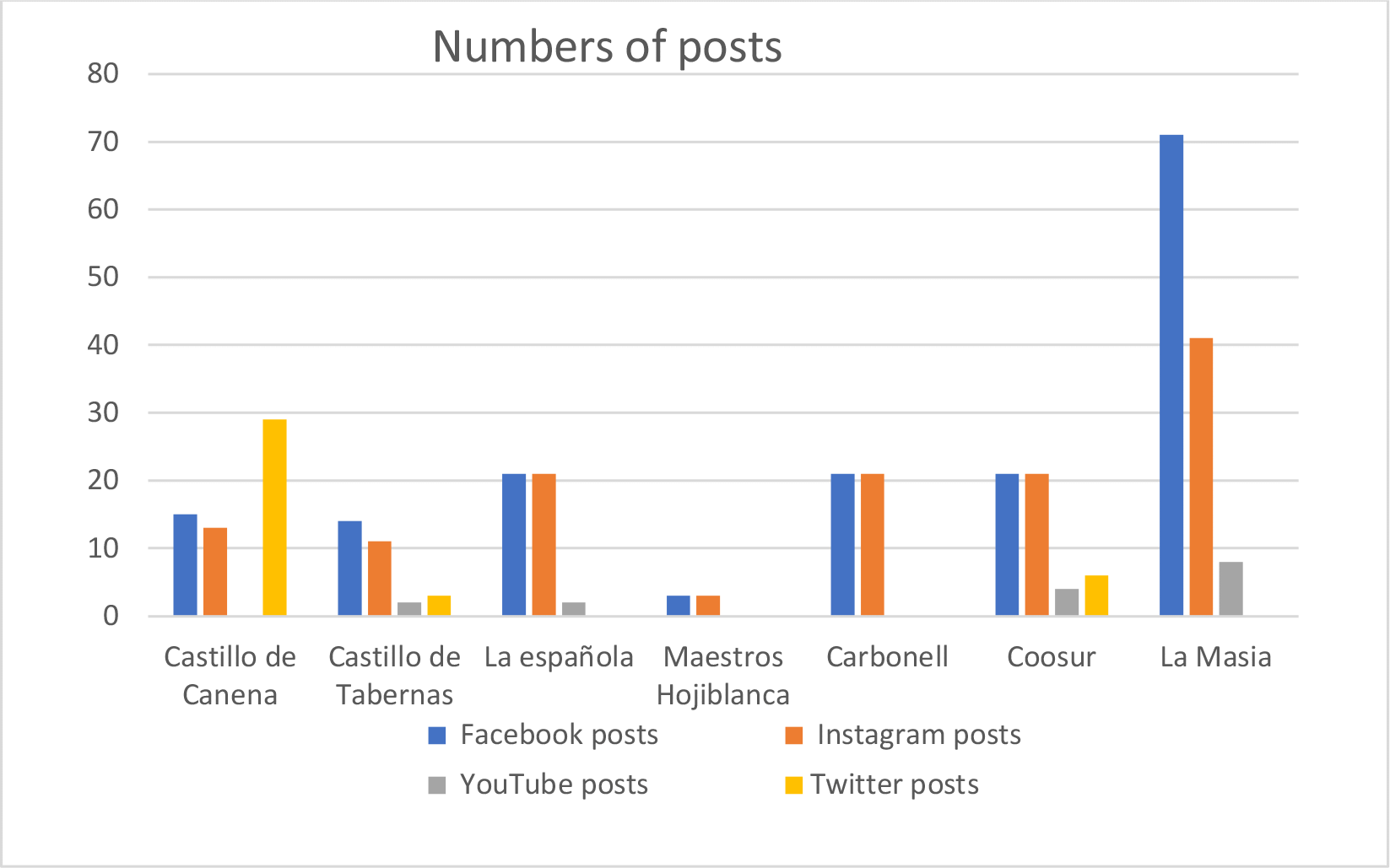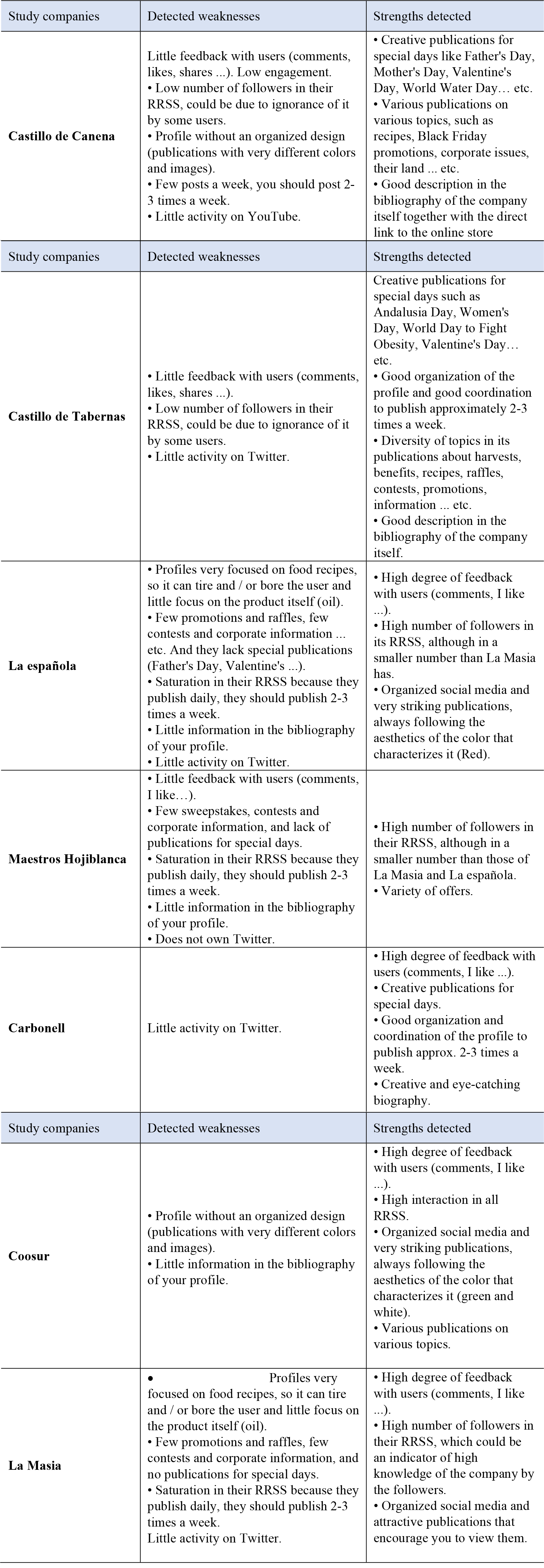Recebido: 22-02-2023 | Aprovado: 29-03-2023
![]() María Illescas Manzano, Universidad de Almería (millescas@ual.es)
María Illescas Manzano, Universidad de Almería (millescas@ual.es)
Como citar este artigo:
Illescas Manzano, M. (2023). Auditoria das redes sociais no sector do azeite
. [RMd] RevistaMultidisciplinar, 5(2), 23-40.
https://doi.org/10.23882/rmd.23134
Abstract: From the analysis of data collected in a survey conducted by 13 February to 13 March 2021 in the social media of both Castillo de Canena and its competitors has already been carried out in the field of social media, in order to be able to compare them and detect the weaknesses of the main company. All the companies studied have a profile created on Facebook, Instagram and YouTube, however, on Twitter not all of them have a profile, especially Maestros Hojiblanca, which is positioned at a very low level compared to Castillo de Canena. The order of use of these RRSS by organizations is respectively Facebook, Instagram, Twitter and YouTube, with Facebook being the RRSS most used both at an organizational level and by users of all ages, followed by Instagram. Castillo de Canena must correct its weaknesses detected in the field of social media in order to position itself at least at the same level as its competition. For this, a series of strategies and tactics or actions are proposed that will help to achieve the objectives that are proposed below. In addition, the actions proposed will be monitored or controlled to verify that they are being carried out correctly and that they are being effective and efficient. Interest to know how the olive sector is working on social networks and to know first-hand what the engagement is in each of the social networks they use.
Keywords: Engagement, social media, Oil sector, audit social media.
Table 1. Engagement
calculation
|
RRSS |
Formula engagement |
|
Facebook |
((Likes+ Shares+ Comments) / Volumen of Fans) *100 |
|
Instagram |
((Likes+ Comments) / Followers) * 100 |
|
Twitter |
((Retweets+ Likes) / nº de tweets) / Followers) *100 |
|
YouTube |
((Likes+ Shares+ Comments) / Views) *100 |
An extra contribution to the PRGS model is the type or format of the
publication, through which the format in which the publications have been
exposed in the RRSS is analyzed (Sánchez et al., 2017).
In short, the variables and / or indicators used to carry out the analysis of
the activity in RRSS of the companies mentioned throughout this work have been
the following (See table 2):
Table 2. Variables to evaluate the activity of companies in their RRSS

3. METHODOLOGY PROCEDURE OF ACTION
After the observation procedure carried out over a month (specifically from
February 13 to March 13, 2021), of the RRSS (specifically on Facebook,
Instagram, Twitter and YouTube) of the different olive companies, a series of
information based on some variables depending on the RRSS to which we are
addressing (See Annex 9.5), which will subsequently help us to identify the
strengths and weaknesses that the main company Castillo de Canena has with
respect to its closest competitors. This action procedure will help us to
implement strategies and tactics that contain both corrective measures and
improvements for the management of the RRSS of Castillo de Canena.
Next, a more specific and brief analysis is carried out taking into account the
variables mentioned in the previous section:
• Presence. To analyze the presence of the chosen olive companies, it will be
analyzed which of them have profiles or accounts officially created in each RRSS
discussed. In addition, in addition, the set of followers and total publications
that each organization has will be analyzed.
Graph 1. Number of followers in the RRSS of each company

Mainly, it is verified that the seven companies have a profile or account open
on Facebook, Instagram and YouTube. However, when studying Twitter, it is
observed that all companies have a presence in it except for Maestros
Hojiblanca, so this detail already makes it different from the others, it can
even position it in a lower position than the rest, in terms of scope of Social
Media is concerned.
The presence section carried out in this study is divided into 2 parts; Total
followers and total posts.
On the one hand, as indicated in graph 1, it is verified that the use of
Facebook's RRSS by the different companies is above all others. On the other
hand, and unlike Facebook, we find YouTube and Twitter, ranking in the queue and
being the least used RRSS by these organizations. By placing Facebook and then
Instagram at the head of the Social Media field, it is pointed out that
organizations bet and invest their time more in them than in others.
Regarding the number of followers (See graph 1), it is worth highlighting the
disproportionate increase in followers in La Masia with the figure of 649,824
and in La española with 364,071 on the Facebook platform, followed by Coosur and
Carbonell, and ranking as the company with less followers on Facebook Castillo
de Canena. This may be due to the fact that La Masia is situated in the minds of
consumers as the best-known olive-growing company with a high degree of
notoriety and memory, in addition to the fact that Facebook is the RRSS most
used by users. However, the opposite happens with Castillo de Canena, obtaining
a lower ranking position in the minds of consumers.
In the followers section, YouTube and Twitter also stand out, being the accounts
least used by users, and thus the ones that receive the least number of
followers in the seven companies mentioned. Finally, it is possible to highlight
a high presence of the organizations on Facebook and Instagram and a residual
presence on both YouTube and Twitter.
Graph 2. Number of publications in the RRSS of each company

Regarding the number of publications (See graph 2), it stands out as Facebook,
in addition to being the social media that has the most followers on average, it
is also the one with the highest number of total publications, followed by
Instagram. You can see how La Masia continues to be at the forefront of the rest
of the companies, publishing on its profile on both Facebook, Instagram and
YouTube on a daily basis and with various publications. The use of Twitter to
publish by companies has increased, this may be due to the fact that this RRSS
has re-emerged among followers and is having a relevant impact on them.
Although the followers in this RRSS are not numerous in each of these companies,
the publications are to a certain extent. Companies have understood the
importance that users are giving to Twitter and are increasing their
publications in order to reach them more directly and interact with them,
turning Twitter into another communication channel as interactive as Facebook
can be. and Instagram.
• Engagement. After checking the number of followers and total publications that
each company has in the different RRSS, that is, after analyzing their presence
in them, the impact that the actions or activities carried out by organizations
have on their RRSS in front of users is examined.
Graph 3. Percentage of engagement in the RRSS of each company

Observing graph 3, it is verified that the percentage of engagement on Instagram
is higher than in any other RRSS, even on Facebook, which has previously been
observed to be the winning platform. This means that on Instagram users are more
linked to the actions that companies carry out through their RRSS and that they
provide greater interaction with them. All this agrees since Instagram is
positioned in the market as a very complete platform in expansion that does not
stop growing, although if you look at it, Facebook (to a lesser percentage) is
not far behind since it is positioned as the most popular RRSS of all the ages.
Continuing with the analysis of engagement, it is concluded that in this case
the organization with the highest percentage of engagement is Carbonell, which
is why it has a high degree of interaction with its users. However, Maestros
Hojiblanca continues to be below all companies in terms of the degree of
interaction with their users.
•Publications. Depending on the type of RRSS in which each company wishes to
publish its publications, one type of publication or another will predominate.
Facebook. On this platform you can publish videos and photos with or without
text, links and / or articles of interest to the public, funny phrases or memes
to attract attention. In addition, you have the option of being able to comment
and react to each publication in order to have a greater degree of interaction
with the user.
Instagram. As on Facebook, on Instagram there is the possibility to publish
photos and videos with or without text, to be able to comment and react on each
publication… etc. However, the only difference is that Facebook's RRSS has users
of a greater age range, so many companies link Instagram posts with Facebook
posts to reach a larger target audience.
Youtube. Unlike the previous RRSS, YouTube leaves aside the photos, emphasizing
videos. The videos can have a maximum duration of up to 12 hours, although in
few cases it happens. As in Facebook and Instagram, the videos can carry an
explanatory or striking text that is crucial to capture the attention of users
on this network, the ability to be commented or reacted. It is a more monotonous
RRSS than the others
After conducting the analysis, it is observed that all or almost all of the
olive companies studied link their Instagram posts with Facebook, with the aim,
as mentioned above, of having a higher percentage of views and reaching more
target audiences. On Facebook and Instagram, organizations often choose the
video format, in which multiple videos of recipes made together with their oil
appear, as is the example of La Masia. On the other hand, they also include
images conducting raffles on special days for their oils or simply photos of
prepared dishes.
On YouTube, all the companies analyzed use this network for corporate purposes
in which their oil mills, work tools, land where they plant their olive trees
for the subsequent production of their oils, presentations of the staff and / or
owners of the organization, etc. are detailed. . It should also be noted that
they make videos in which it is indicated how the olive is harvested or other
procedures carried out in the olive groves.
Finally, on Twitter they publish content similar to that of Instagram and
Facebook, referring to special days such as Mother's Day, raffles ... etc.
However, there is a relevant aspect in this RRSS, this being the one that most
of the publications of these organizations on Twitter are based on sharing
content published by other accounts that mention them. This aspect can help the
reputation of the company, since this way the users themselves can see for
themselves the prestige of the organization by being mentioned by other
institutions for any action carried out, such as attending congresses or olive
oil fairs, in addition to being mentioned for the quality of its products.
4. RESULT
Table 3. Comparison of the different companies in the sector in the RRSS

5. CONCLUSION
With the completion of this research work, it has been concluded that we live in
a world in which the existence of RRSS in the business environment is considered
a very important and necessary factor. Their impact on society has positive or
negative repercussions, depending on how they are managed by each organization.
Its good management has positive consequences in the creation of long-term
relationships with users, in addition to increasing interaction with them,
promoting more fluid and interactive communication. Most companies use RRSS to
attract more users who feel they belong to the brand, and to make these users
feel committed to it.
The olive-growing sector is not a sector that is identified by having a great
communication channel through the RRSS, but it is true that more and more are
increasing their activity in them, turning the Social Media field into a perfect
medium to communicate with its users. After carrying out the study of the
Castillo de Canena company and its competence in RRSS, the following main
conclusions have been obtained.
On the one hand, all the companies studied have a profile created on Facebook,
Instagram and YouTube, however, on Twitter not all of them have a profile,
especially Maestros Hojiblanca, which is positioned at a very low level compared
to Castillo de Canena The order of use of these RRSS by organizations is
respectively Facebook, Instagram, Twitter and YouTube, with Facebook being the
RRSS most used both at an organizational level and by users of all ages,
followed by Instagram. On the other hand, there is Twitter that is emerging
among companies as a communication channel, because new users are currently
being added and they can use these advantages to turn that channel into a medium
as interactive as Facebook or Instagram.
Most of these organizations' posts on Twitter are based on sharing content
posted by other accounts that mention them. This aspect can give the company a
greater reputation for being mentioned by other institutions. In other
conditions, it is observed that the analyzed companies use YouTube for more
corporate purposes in which their oil mills, work tools, land where they plant
their olive trees for the subsequent production of their oils, presentations of
the staff and / or owners of the organization are detailed. …etc. However, it
should be noted that study companies link their Instagram posts with Facebook,
in order to reach more audiences. Despite linking the publications of both RRSS,
there is a great difference in the degree of engagement or interaction with
users, presenting a higher percentage of engagement on Instagram than on
Facebook, so it could be said that, although Facebook is the RRSS more known and
used, on Instagram a higher degree of engagement with the user is achieved.
After conducting the study, it was observed that La Masia, apart from
positioning itself in the minds of consumers as the best-known company with a
high degree of notoriety and memory, also has the highest percentage of
engagement on Facebook. Hence, the existence of its high number of followers and
daily publications in that same RRSS can be verified. Regarding the number of
followers on Facebook, La española also stands out. Unlike La Masia and La
española, Castillo de Canena has a lower number of followers, due to the low
knowledge of users about it.
Considering La Masia and La española as the two best-positioned competitors of
Castillo de Canena in the Social Media field, the completion of this study has
led to the setting of goals and strategies by Castillo de Canena in its RRSS to
improve its presence and its competitive position.
Finally, it should be noted that outside the field of Social Media, the
competing company of Castillo de Canena that is best positioned in the market is
Coosur.
Referências